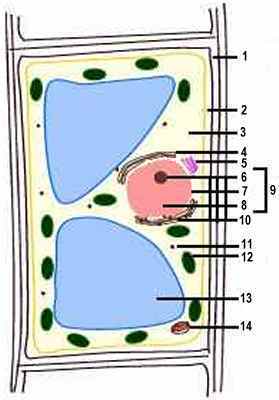Try the Quiz : Biology Quiz : Plant Cell Diagram
 |
apid |
Just what you need to know! |
| eview |
|
LABEL (ON DIAGRAM) :
CELL PART :
EXPLANATION- 1 : Cell Wall
- The cell wall is the outermost covering of the plant cell made up of cellulose, and surrounds the cell membrane. It protects the cell, provides mechanical support and is responsible for maintaining pressure inside the cell.
- 2 : Cell Membrane
- The cell membrane is also known as the plasma membrane. It lies beneath the cell wall of the plant cell. It is selectively permeable and regulates the entry and exit of substances, namely ions and solutes.
- 3 : Cytoplasm
- The cytoplasm is composed of a mixture of water and soluble organic & inorganic compounds, and contains most of the cell organelles. It is the house of all metabolic functions and activities of the plant cell.
- 4 : Smooth Endoplasmic Reticulum
- The smooth endoplasmic reticulum consists of tubular structures (convulated tubules) lying near the nucleus and does not have ribosomes attached to it. It provides support to the plant cell.
- 5 : Dictyosome
- The dictyosome of the plant cell consists of flat vesicular structures placed one on top of the other. It synthesizes and secretes certain substances, namely hormones and enzymes.
- 6 : Nucleolus
- The nucleolus is contained in the nucleus of the plant cell, and is round in shape. It synthesizes proteins by producing and storing RNA (Ribonucleic acid).
- 7 : Nuclear Membrane
- The nuclear membrane is the covering of the nucleus of the plant cell, and has numerous pores. It allows substances to enter and leave.
- 8 : Nucleoplasm
- The nucleoplasm of the plant cell is a dense fluid containing chromatin fibres, which are made up of DNA (Deoxyribonucleic acid). After cell division takes place, these chromatin fibres undergo certain structural changes, and are called chromosomes. These chromosomes carry the hereditary information of the genes.
- 9 : Nucleus
- The nucleus is the most important part of the plant cell, and contains large amounts of DNA (Deoxyribonucleic acid). It controls and coordinates all the activities and functions of the cell.
- 10 : Rough Endoplasmic Reticulum
- The rough endoplasmic reticulum consists of tubular structures (convulated tubules) lying near the nucleus and has ribosomes attached to it. It provides support to the plant cell.
- 11 : Ribosome
- The ribosome of the plant cell is chiefly composed of RNA (Ribonucleic Acid). It synthesizes proteins.
- 12 : Chloroplast
- The chloroplast of the plant cell is a green-colored plastid. Chlorophyll contained in the chloroplast captures energy from sunlight and helps in the manufacture of food by the process of photosynthesis.
- 13 : Vacuole
- The vacuole of the plant cell is a very large and abundant vesicle. It is filled with fluids, and helps in the storage of water and other substances.
- 14 : Mitochondrion
- The mitochondrion of the plant cell has two layers of membrane, of which the inner one is folded to form cristae. It is the site of ATP (Adenosine triphosphate) synthesis.
Try the Quiz : Biology Quiz : Plant Cell Diagram

